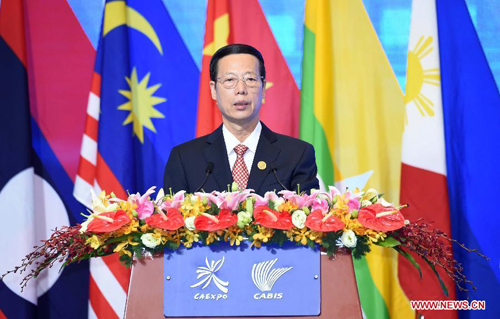Belt and Road
Your Present Location: PROGRAMS> Belt and RoadBelt and Road good for China, ASEAN

Chinese Vice Premier Zhang Gaoli addresses the opening ceremony of the 12th China-ASEAN Expo and the China-ASEAN Business and Investment Summit, in Nanning, capital of south China`s Guangxi Zhuang Autonomous Region, Sept. 18, 2015. (Xinhua/Zhang Duo)
Source: Xinhua Published: 2015-9-18
The ancient maritime silk road once facilitated trade and cultural exchange between China and its Southeast Asian neighbors. Hopes are high that its successor, the 21st Century Maritime Silk Road, will inject new impetus into regional development.
The 12th China-ASEAN Expo opened on Friday in Nanning, capital of south China` s Guangxi Zhuang Autonomous Region, under the theme "creating a new blueprint for maritime cooperation by jointly building the 21st Century Maritime Silk Road."
Addressing the opening ceremony, Chinese Vice Premier Zhang Gaoli said the "Belt and Road" initiative can promote economic prosperity and regional economic cooperation, enhance exchanges, promote world peace and development, and benefit the people of many countries around the world.
The Belt and Road was proposed by China in 2013 as a trade and infrastructure network. It will connect Asia, to Europe and Africa through the Silk Road Economic Belt and the 21st Century Maritime Silk Road.
The expo, scheduled to run from Friday to Monday, has attracted over 2,200 companies from China and ASEAN.
DEVELOPMENT, TOGETHER
Zhang said that Belt and Road construction is entering a new phase of pragmatic cooperation.
Referring to the establishment of the ASEAN Economic Community (AEC) by the end of this year, Zhang said that integration between the Belt and Road, the AEC construction blueprint, and ASEAN development strategies should be pursued.
In 2003, a concord on establishing the AEC by 2020 was inked by all its member countries. In 2007, it was decided that the community should be established by 2015.
Also attending the opening ceremony, Myanmar Vice President Sai Mauk Kham said the 21st Century Maritime Silk Road initiative will help facilitate communication and cooperation among ASEAN members, and contribute to the development of infrastructure and integration of the AEC.
Vietnamese Deputy Prime Minister Nguyen Xuan Phuc spoke highly of the Belt and Road initiative, saying that the expo will bring development opportunities to companies, and continue serving to bridge China and ASEAN.
TRADE, INDUSTRIAL COOPERATION
Zhang called economic and trade cooperation the foundation of the construction of the Belt and Road.
He stressed the importance of closer ties in customs, inspection and quarantine, certification, standard measuring, information collection between China and ASEAN, to lower non-tariff barriers and facilitate bilateral trade.
China aims to elevate bilateral trade with ASEAN to 1 trillion U. S. dollars by 2020, according to the vice premier.
While China is ASEAN`s largest trading partner, ASEAN is China`s third largest trading partner. Trade between China and ASEAN increased 8.23 percent year on year to 480 billion U. S. dollars in 2014.
Zhang also pledged cooperation in production capacity, saying that China was willing to cooperate with ASEAN in such areas as electricity, engineering machinery, building materials and communication.
The pledge was welcomed by Thai Deputy Prime Minister Tanasak Patimapragorn, who said China`s move to accelerate production capacity cooperation with ASEAN would bring benefits to both sides.
INFRASTRUCTURE CONSTRUCTION
During the opening ceremony, Zhang Gaoli called for highways and rail to link west China and the Indo-China Peninsula including Vietnam, Laos, Cambodia, Thailand, Malaysia and Singapore.
Laotian Deputy Prime Minister Somsavat Lengsavad told Xinhua that the construction of a railway that links China`s Kunming City with the capital city of Laos, Vientiane, was scheduled to start by the end of this year.
Currently, China and Thailand are negotiating a medium-speed railway line, which will connect northeast Thailand`s Nong Khai province, capital Bangkok and eastern Rayong province.
The railway project, once completed, could serve as a Belt and Road model and demonstrate to the world how projects of its kind can promote the economy, said Huang Bin from Kasikorn Research Center, a Thai think tank.
Zhang also noted that China was willing to join hands with ASEAN to establish the China-ASEAN Information Harbor.
The harbor initiative, proposed by China last September, is an economic and technology cooperation project that will be an information hub for the 21st Century Maritime Silk Road.
The initiative will include five cooperative platforms to benefit China and ASEAN, covering infrastructure, information sharing, technological innovation, trade service and cultural exchange.
Key Words: China; ASEAN; Belt and Road























































































 京公网安备 11010802037854号
京公网安备 11010802037854号





